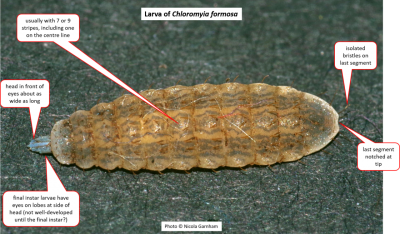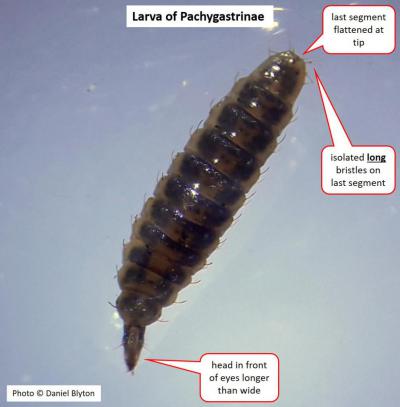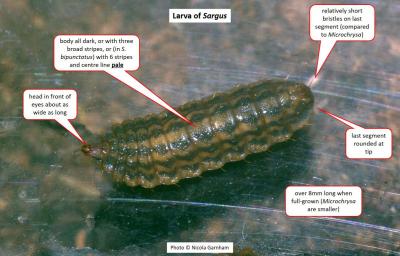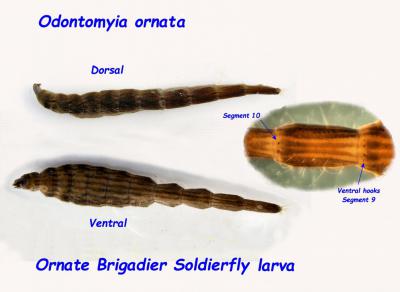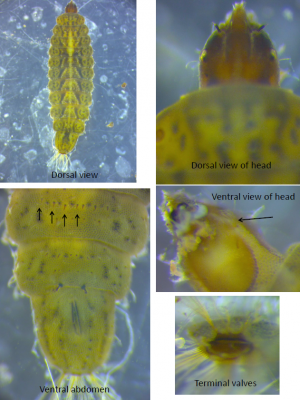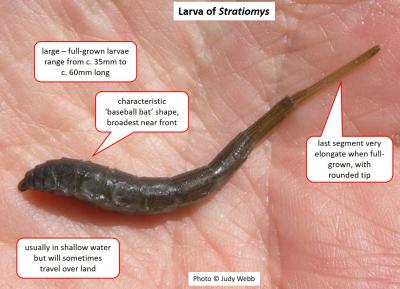Early stages of Stratiomyidae (soldierflies)
This page provides a guide to some of the genera of soldierflies, with links to species information and images where these are available. Thank you to everyone who has allowed their images to be shared.
General
- For an introduction to rearing terrestrial soldierfly larvae see Jane Thomas' article in Soldierfly Newsletter 8 (or download from the newsletters page), with further photos available in Jane's Flickr albums.
- Lock, K., van Haaren, T., Tempelman, D., Chérot, F., and Adriaens, T. 2013. Distribution and ecology of soldier fly larvae captured in Flemish surface waters (Diptera : Stratiomyidae). Bulletin de la Société royale belge d’Entomologie/Bulletin van de Koninklijke Belgische Vereniging voor Entomologie, 149: 150–159. Includes figures showing Oxycera meigenii, Oxycera pardalina, Odontomyia ornata and Odontomyia tigrina and information on how to distinguish these species.
- Visit Jonathan Neal's blog to see a superb close-up by Fabrice Parais of the delicate, feathery respiratory hairs at the tip of a soldier-fly larva.
Soldierfly larvae can be grouped into "aquatic species" that have larvae developing under water, and "terrestrial species" that are on land. The "terrestrial" larvae are usually found in damp microhabitats, e.g. among leaf-litter or in compost heaps, There can be some overlap, e.g. at the edges of water bodies or around seepages, and in genus Beris both B. clavipes and B. vallata are amphibious.
Recognising the genera - terrestrial species
Genus Chloromyia
Just one species in this genus, C. formosa, that has a fairly distinctive striped appearance with a notched 'tail'. (Sargus bipunctatus is also striped, but is pale on the midline of the body.)
- Go to Chloromyia genus page
Genus Chorisops
Two species in this genus (C. nagatomii and C. tibialis), and there are no known features for distinguishing the larvae. The larvae can be readily found among leaf litter and under stones.
- Go to Chorisops genus page
Subfamily Pachygastrinae
Five species in four genera.
Genus Sargus
Four species. Sargus bipunctatus has distinctive stripes, but the others are darker. Microchrysa larvae are similar but smaller.
- Go to Sargus genus page
Recognising the genera - aquatic species
Odontomyia ornata (Ornate Brigadier)
Photos by Adrian Chalkley, from Oulton Marshes in Suffolk. They show the larva of Odontomyia ornata. Both adult and larval O. ornata are rather similar to species in genus Stratiomys, but as Adrian's photos clearly show, the larva has characteristic hooks on the underside of segments 9 and 10 (these hooks are absent in Stratiomys). Larvae of O. ornata can be easier to find than the adults, and are most often found in grazing marsh ditches with aquatic, floating vegetation.
Oxycera rara (Four-barred Major)
Photos by Martin Winter of the Environment Agency. It was found at Oxton Dumble, Oxton Ford, (just north of Nottingham), grid ref SK 63050 51251 on 14 March 2016. The stream is small, only 1–2 meters wide, and shallow, 20cm deep with some gravelly riffle habitat, but quite silty and slow in most places. The chevron markings were clear and there were 8 stiff bristles or teeth on ventral S5-9.
Probably Oxycera morrisii (White-barred Soldier)
Photos by Glen Meadows. Collected in February 2018 from an ephemeral reach of the river Thames from a kick sample.
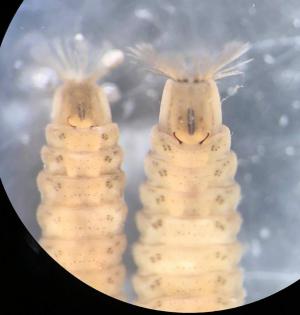 |
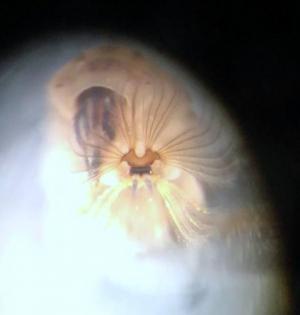 |
Genus Stratiomys
Four species in this genus. The genus is quite distinctive, not least because of the large size of the full-grown larvae (up to 60mm long), but the species are difficult if not impossible to tell apart as larvae.
- Go to Stratiomys genus page

